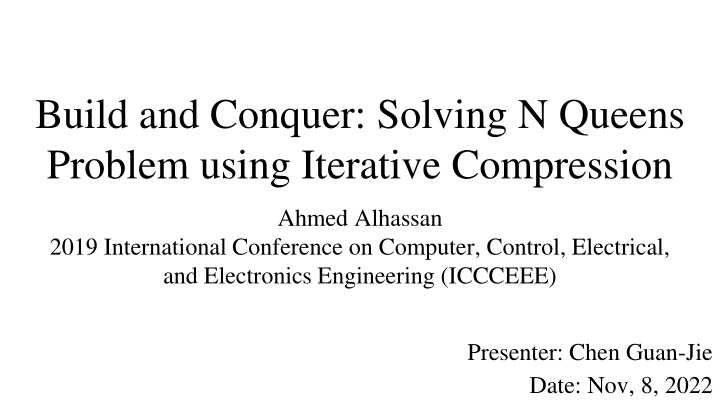
Solving N Queens Problem with Iterative Compression Approach
"Explore a novel approach to solving the N Queens problem by connecting different orders and using iterative compression to place queens on the board. Learn about the rules of queen attacks, backtrack and backjump algorithms, and time complexity analysis. Discover solutions and nonattacked corners in this intriguing study presented at ICCCEEE 2019."
Download Presentation

Please find below an Image/Link to download the presentation.
The content on the website is provided AS IS for your information and personal use only. It may not be sold, licensed, or shared on other websites without obtaining consent from the author. If you encounter any issues during the download, it is possible that the publisher has removed the file from their server.
You are allowed to download the files provided on this website for personal or commercial use, subject to the condition that they are used lawfully. All files are the property of their respective owners.
The content on the website is provided AS IS for your information and personal use only. It may not be sold, licensed, or shared on other websites without obtaining consent from the author.
E N D
Presentation Transcript
Build and Conquer: Solving N Queens Problem using Iterative Compression Ahmed Alhassan 2019 International Conference on Computer, Control, Electrical, and Electronics Engineering (ICCCEEE) Presenter: Chen Guan-Jie Date: Nov, 8, 2022
Abstract (1 / 2) The N queens problem is a very hot topic for research use. Nonetheless all previous algorithms that solved the N queens problem treat each order of it as if they are separate problems with no connection among them. The main idea of this paper is to connect the dots among various orders of the N queens problem and demonstrate that all orders of the N-queens problem are connected with each other. 2
Abstract (2 / 2) And then we propose an algorithm using iterative compression to solve the problem i.e. beginning from the solution of the least order of the problem and then by using the relation among different orders we add a queen in every iteration until we have the N queens residing in the NxN board. 3
Rules (How queen attacks) (1) There are no queen sharing the same row with any other queen. (2) There are no queen sharing the same column with any other queen. (3) There are no queen sharing the same diagonal with any other queen. 4
Backjump Algorithm 6 to 4 (B.J.) instead of 6 to 5 (B.T.) Conflict set: (1, 3, 2, 4, 3, 1, 2, 3) (Row-major) 7
Backtrack & Backjump Time Complexity: O(N!) 8
Build and Conquer - Nonattacked Corners - Solution - Pseudo-solution 9
Nonattacked Corner BFS 14
Result ? using DFS / BFS 15
Build and Conquer Time Complexity: O(C * (N )) C: the number of configurations we search in order to generate the solutions 16
Reference Vishal Kesri, Vaibhav Kesri, and Prasant Ku. Pattnaik. An Unique Solution for N queen Problem International Journal of Computer Applications (0975 8887) Volume 43 No.12, April 2012 ECE 566 Constraint Satisfaction Problems and Techniques https://iq.opengenus.org/backjumping/ 17
